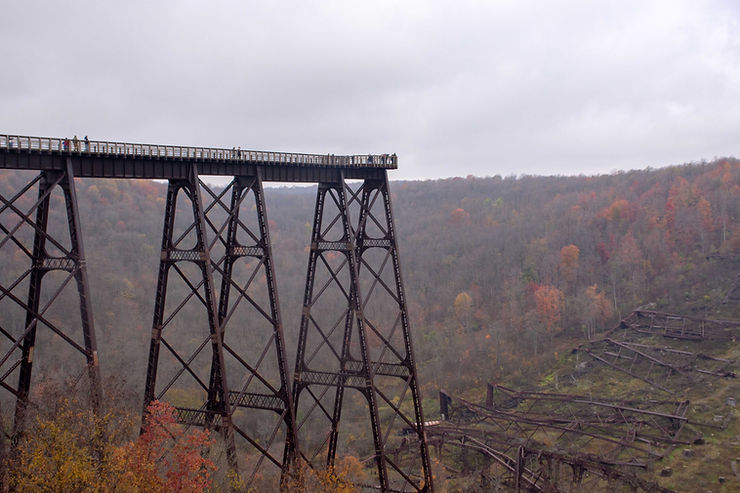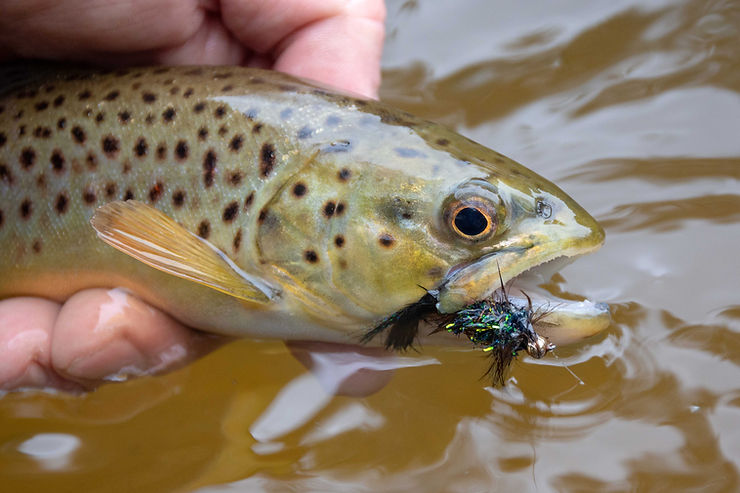Fly Fishing on Kinzua Creek

Kinzua Creek is a 26.5-mile tributary of the Allegheny Reservoir in northwestern Pennsylvania. The stream can be divided into two distinct sections with the line of demarcation between uninhabitable and habitable trout water being Kinzua Bridge State Park. Here Kinzua Creek basically transitions from a swampy, willow-lined mess into the beautiful mountain trout stream you see downstream.
The lower 15 miles of Kinzua Creek flow through the Allegheny National Forest (ANF) and access is generally excellent. A 4.77-mile section from Guffey Road Bridge (Rocky Road) downstream to the ANF border near Westline is designated as delayed-harvest/artificial-lures-only. This stretch is also part of the Keystone Select waters program and is stocked with larger-than-average trout.
The delayed-harvest section of Kinzua Creek has a lot of character. Generally speaking, Kinzua Creek averages around 40 feet wide, but it’s like a small mountain brook on steroids, with deep pools pushing up against vehicle-sized rocks, overhanging ledges and undercut banks. You begin at almost any point along the stream and expect to be on fish right away.
The special regulations waters can be reached via State Route 219, which crosses this section at about the midpoint. Downstream from SR 219, State Road closely follows the lower half of the delayed-harvest down to the town of Westline. From there, you can either turn left onto Forest Service Road 321 or continue straight onto Forest Service Road 122. Kinzua Creek flows almost equidistant between these two roads, but each road provides better access to different parts of the stream. Numerous campsites are available along the ANF portions of the stream.
The main access point upstream of SR 219 can be found in Kushequa, a small town that can be reached by turning north onto Kushequa Avenue off of Route 6 in Mount Jewett. The first stocking point along Kinzua Creek is approximately 0.8 miles upstream of the bridge in Kushequa.
Unfortunately, Kinzua Creek is not stocked closer to Kinzua Bridge State Park, although trout certainly find their way up there. The stream can be accessed within the park but requires a steep downhill hike. To get a better understanding of the difficult hike required to get down to the stream, journey out onto the Kinzua Skywalk and view the valley from overhead. The skywalk was constructed on six of the remaining steel towers after a tornado destroyed most of the railroad viaduct in 2003. At the time, this railroad bridge was highest and longest in the world. Today, the skywalk features a 624-foot walkway with a set of railroad tracks leading out over the Kinzua Gorge and a panoramic view of the valley. It’s not for the faint of heart, especially considering that the overlook has a partial glass floor.

Kinzua Bridge State Park and the Skywalk is a “must-visit” any time I’m fishing this region. The view of the valley is breathtaking
Most of the upper half of the stream above Kinzua State Park runs through private land owned by mineral, gas, or logging companies. Many environmental reports suggest that the upper reaches are void of fish due to its natural acidity and the effects of the industry that once lined its banks. That’s also why the stream doesn’t contain a large variety of mayflies, although they’ve gradually improved over the years.
For what it lacks in variety, Kinzua Creek makes up for with uniquity such as its large population of baetisca, known as “armored mayflies.” They’re roughly size 14 with a protective, diamond-shaped, shell-like case that gives them a hump-backed appearance. Baetisca are unique in that, like stoneflies, they crawl up onto land before metamorphosing into adults, and hatches appear sporadically throughout May and early June.
The species of baetisca found in Kinzua Creek is best-matched with a fly with a dark brown body and mix of brown and black hackle. The body of the fly, though, is tied thicker than usual, and this often means the difference in a selective trout refusing or accepting your offer. For subsurface fishing, a beefed-up black Hare’s Ear Nymph with an over-sized wing case comes really close to matching the baetisca nymphs.
Kinzua Creek has a wide variety of caddis hatches and lots of stoneflies, sculpins, crayfish, and giant salmonflies. It seems there’s plenty of food here for even the most discerning trout.

Black-colored flies work especially well in Kinzua Creek thanks to water color and various conditions
The water does stay cold enough to support trout year-round as it flows through a heavily-canopied forest. Trout fishing can get tough once the water drops to summer levels, but by mid-June smallmouth bass begin working up into the stream from the Allegheny Reservoir in good numbers. Autumn months also bring an opportunity for a decent fall-run of browns coming from the same system. No matter the time of year, there’s always a good reason to fish Kinzua Creek.
____________________
This article appeared in the November/December 2022 issue of American Fly Fishing magazine. Watch a video about fishing KINZUA CREEK on a fall evening below.
Sign up for the Dark Skies Fly Fishing e-newsletter
It's free, delivered to your inbox approximately three times each month.
Sign Up Now